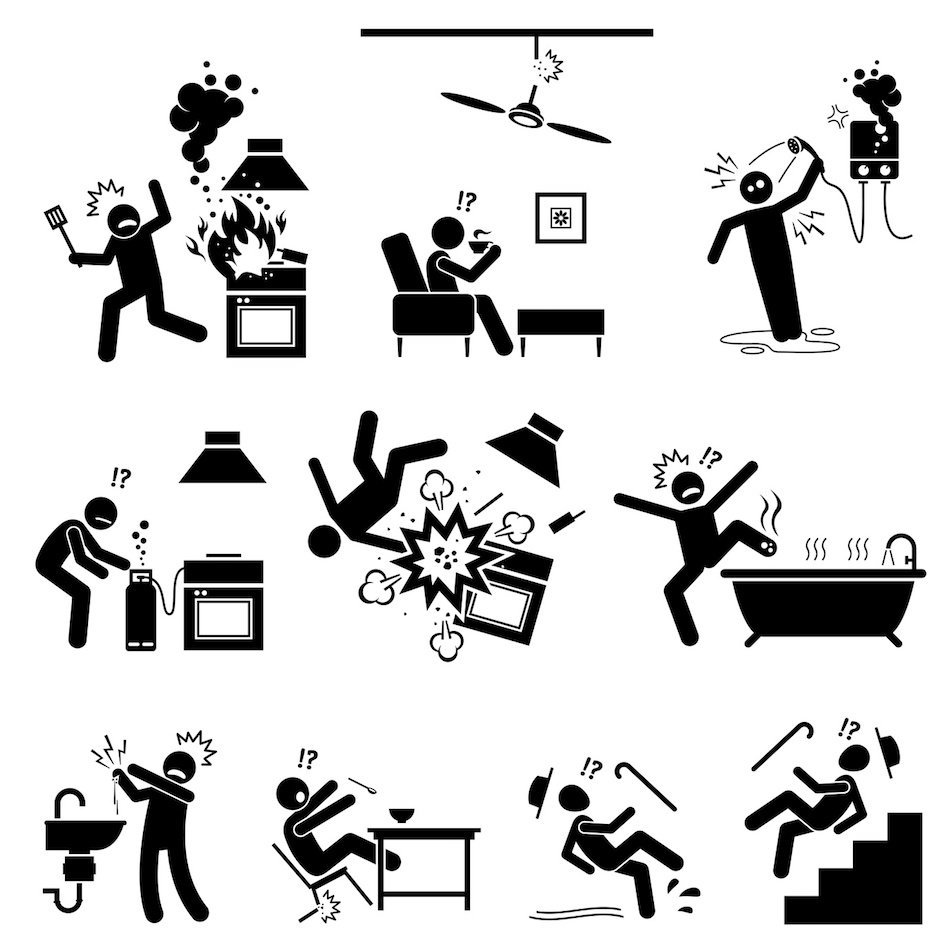10 Most Common Home Safety Hazards - Staying Safe at Home
Posted by Gary Ashton on Thursday, July 6th, 2023 at 7:12am.
 Too many homeowners underestimate the potential safety hazards lurking within their own homes. It is essential to be aware of these hazards and take proactive steps to safeguard yourself and your family. This article will highlight the most common home safety hazards and provide practical prevention measures.
Too many homeowners underestimate the potential safety hazards lurking within their own homes. It is essential to be aware of these hazards and take proactive steps to safeguard yourself and your family. This article will highlight the most common home safety hazards and provide practical prevention measures.
Top 10 most common Home Safety Hazards:
- Falls: Tripping hazards, unsecured rugs, and slippery surfaces can lead to falls and injuries.
- Fire hazards: Including faulty wiring, unattended candles, improper use of space heaters, and cooking accidents.
- Carbon monoxide: Malfunctioning heating systems, blocked vents, or improper use of fuel-burning appliances can lead to carbon monoxide poisoning.
- Poisoning: Exposure to toxic substances such as cleaning chemicals, pesticides, and medications.
- Electrical hazards: Faulty wiring, overloaded circuits, and exposed electrical components.
- Drowning: Unsecured swimming pools, open bodies of water, and lack of proper pool safety measures.
- Burns: Hot surfaces, scalding water, and unsafe use of cooking appliances.
- Choking and suffocation: Small objects, loose cords, and improper crib bedding can pose risks, especially for children.
- Structural hazards: Unstable stairs, loose handrails, and deteriorating building materials.
- Home invasion: Insufficient security measures and lack of proper door and window locks.
Poisoning
One of the biggest hazards in a home involves some items we bring ourselves. If you are like a traditional family, you likely have many cleaning products stored away. You use these products to keep your home clean, but if they fall into the wrong hands, they could be a recipe for disaster. These products have warning labels that detail just how dangerous they can be.
If any animals or children visit your home, you must keep these hidden and locked away. Many people tend to put them under the kitchen sink, which may be one of the worst places to put them because young children or pets can easily find them. Instead, you should put them where they cannot be reached, such as a high shelf.
Carbon Monoxide
Carbon monoxide is a highly toxic gas, but its problem is that it does not have a taste, color, or odor, making it impossible to detect on your own. Carbon monoxide can cause you to pass out and even die if you are not removed from the area in time. This deadly gas can be caused by various things in the home, including your fireplace, stove, and even your vehicle.
Hhaving a carbon monoxide detector in your home is always a good idea. This device will detect the carbon monoxide in the home and sound an alarm so your loved ones can get out in time. Some will also call the fire department on your behalf, and others will integrate seamlessly into a smart home setup.
Fires in the Home
Another hazard in the home that homeowners are likely more aware of is Fires. Fires in the home can occur unexpectedly, stemming from various sources such as faulty electrical plugs or wiring within the walls and malfunctioning appliances. Even the use of candles, despite their aesthetic appeal, carries the potential risk of igniting a fire. While it is possible to detect the presence of a fire occasionally, there are instances when it may go unnoticed, especially if one is not present or attentive to intervene before it escalates.
It is crucial to have a functioning fire alarm in the home to promptly notify homeowners and authorities of a fire, regardless of the homeowner's presence or state of sleep. Fires can rapidly engulf a home, underscoring the importance of timely response, making a fire alarm an essential safety measure. Homeowners should also regularly check and ensure the batteries are charged, ideally every quarter.
Most Common Causes of House Fires:
| House Fire Hazards | Prevention Measures |
|---|---|
| Cooking accidents | Never leave the stove unattended and avoid distractions in the kitchen. |
| Electrical malfunctions | Regularly inspect wiring, replace damaged cords, and avoid overloading outlets. |
| Candles | Use flameless alternatives or keep candles away from flammable materials and extinguish them before leaving the room. |
| Smoking materials | Never smoke indoors, properly dispose of cigarette butts, and avoid smoking while drowsy. |
| Heating equipment (e.g., space heaters) | Keep heaters at least three feet away from flammable objects and turn them off when unattended or during sleep. |
| Faulty appliances | Regularly maintain and repair appliances to prevent electrical or mechanical malfunctions. |
| Carelessness with fire (e.g., matches) | Store matches and lighters out of reach of children, and educate family members about fire safety. |
It’s a tedious job that many of us often overlook, but it's important to be diligent with home fire safety and keeping up with smoke alarm battery maintenance. Investing in a couple fire extinguishers and placing them throughout your home is also a great idea and something to keep in mind as well.
Winter Falls in Icy Climates
While we don’t normally see a lot of snow and ice in the Nashville area, always be quick about getting your sidewalks, decks, and driveways cleared off when nasty weather hits our area. Remember, there’s nothing more dangerous than an icy walkway!
There are a lot of different hazards in your home but there are also ways to avoid them and protect your home and your family against them.

Gary Ashton
The Ashton Real Estate Group of RE/MAX Advantage
The #1 RE/MAX team in the World!
